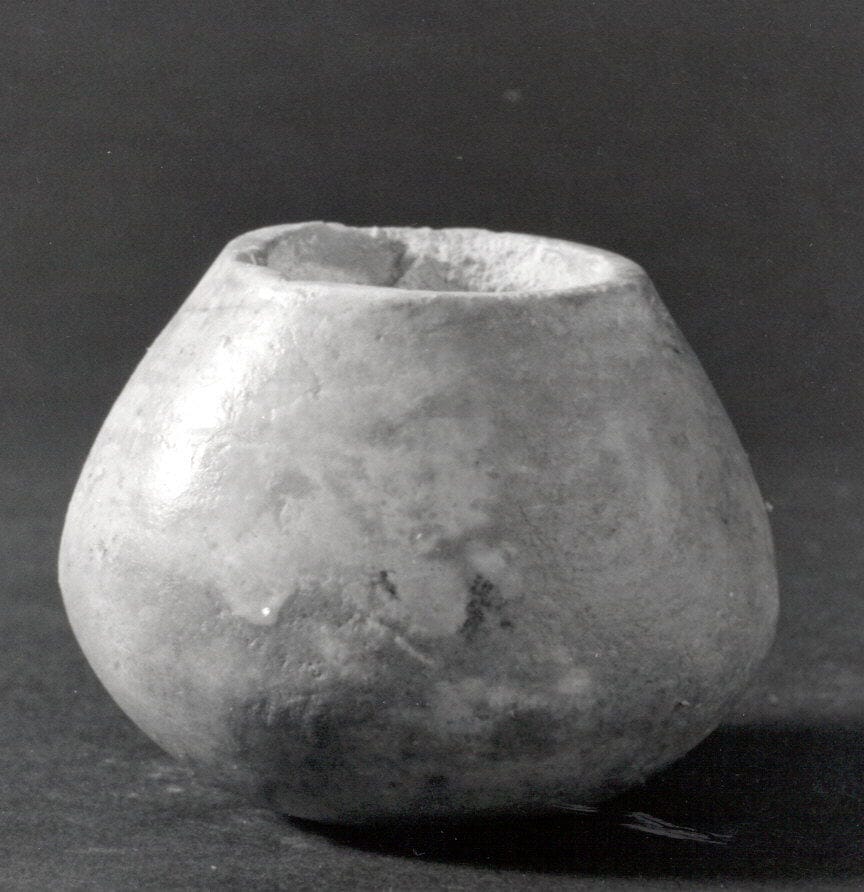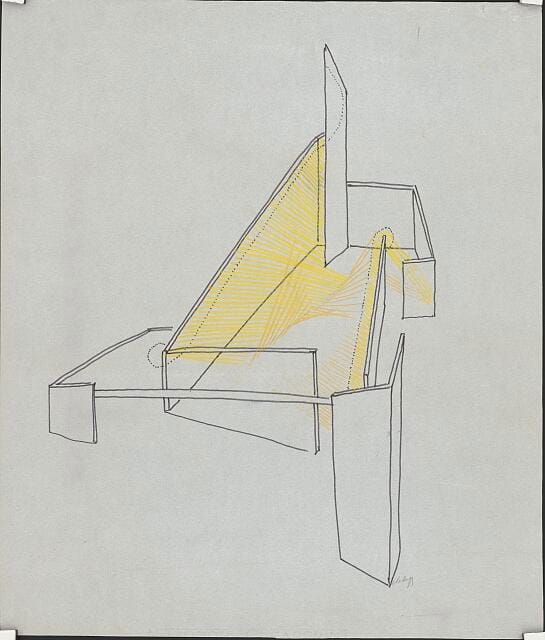Containment
Menstrual products, chest binders, and power.

“Containment implies that the substance it encloses has power — that it is pressurized with meaning.” — Sophie Strand
When I was trying to conceive, I worried about leaving blood in public men’s rooms. I’d empty my cup and it would drip on the seat, or I’d see a long strand on the lip of the toilet bowl, plainly in view of whoever raised the seat next. I developed the habit of checking everything very carefully, making sure to leave no trace that someone might be menstruating here in this room exclusively for the business of men.
Despite my obsessive care to keep the men’s room stall tidy, I had no problem washing out the cup at the sink, though I was careful to wipe the blood off first with toilet paper and to try to contain the cup in my hand while washing. I figured no one would know what it was, and even if they did, to comment or inquire would be such a massive breach of men’s room etiquette as to be easily deflected.
What poems, I wonder, could I have written with the mental energy I’ve instead used to triple-check the toilet stall, decide on my comfort level with rinsing out my cup, calculate whether I’ll have to navigate the men’s room cup change again or whether I can wait until I get home? I’ll never know.
Once, I misjudged this calculation, and found myself bleeding through my pants while assisting a colleague with a work presentation. While distributing handouts in an auditorium of over a hundred people, I felt that distinctive ‘bloop’ feeling that—for someone exclusively using a menstrual cup—always indicates serious trouble. I immediately walked out of the auditorium, out of the building, went straight home, and changed. No one in that audience knew I was trans. And even some close colleagues didn’t know I was trying to conceive. That blood was, in Strand’s words, “pressurized with meaning.” It was urgently in need of containment.
Reflecting on this now—this particular blood, its set of meanings, the urgency of its containment—I find myself wondering about why the same level of urgency is applied to the containment of cisgender women’s menstrual blood, which contains no particular secrets about anyone’s gender identity or reproductive intentions.
The extreme caution and secrecy with which I approached my period as a transgender man were continuations of my menstrual experience as a cisgender woman, not a departure from them. It was as a young woman that I learned to discreetly palm a menstrual product, to speak of my period in coded language, and to devote excessive mental energy to the prevention of any potential leak.
As a transgender person, at times my life feels like a containment project for my body’s femaleness. I’m not sure I’m even supposed to use the word “femaleness” to refer to my body, as though my body’s femaleness needs to be contained both linguistically and practically. I choose language that reframes my body’s parts and functions in ways that are pleasing to me. I may wear a chest binder or a silicone cock. I devote energy to considering with whom to share these aspects of my story, and to exactly how I will talk about them. I often lack language to discuss my body’s functions and activities in ways that feel consistently affirming to me. At times, there has been a sense of lack, of not-quite-realness, of approximation.
With this in mind, it makes some sense to me why, as a transgender man, I’d devote substantial effort to containing all evidence of my menstruation.
What makes less sense to me, then, is why every single behavior I had around containing my period is something I had already learned as a cisgender woman, someone for whom this function of my body was, supposedly, normal and expected.
When I speak about containment of menstruation, I would like to draw a distinction between practical containment and cultural containment. I am not, of course, suggesting that we all consistently embrace the practice of free bleeding (although I will say that perhaps it has its place—for those whose homes have hardwood or linoleum flooring, not carpets) but rather that I must question the extent of secrecy and fear around containing all evidence that we are menstruating—including secrecy around products and discussion. This cultural practice of containment goes far beyond any legitimate concerns about hygeine or stained upholstery.
Because of the degree to which menstruation is culturally contained, I can only surmise that in Strand’s words, it is pressurized with meaning, that it has power. If containment implies that the substance it encloses has power, what power are we to understand is being contained by efforts to contain menstruation?
Here I would like to resist, or at least complicate, any pat answers around “women’s power,” “fertility,” etc, although I honor those who claim and experience their menstrual cycle in this way. For obvious reasons, these particular words don’t resonate for me, as someone who menstruates and does not identify as a woman, as someone who menstruates and was not able to get pregnant when he wanted to be. I don’t doubt that there is some truth to these answers, but I suspect something deeper may be at play here.
For me, my period invites me more deeply into an experience of time as nonlinear, which invites me also to experience my life as nonlinear. Most of my life has been about striving, about moving toward the next goal. My period reminds me that I’m actually moving in a circle. This is exceptionally destabilizing to capitalism—how then can I be manipulated to buy products I don’t want, to chase promotions and raises I don’t need, to show up every day and produce at exactly the same rate? My period reminds me that I am not a machine. My period invites me to rest and reflect.
Further, my period rewrites my understanding of history. Judy Grahn notes that the distinction between bleeding and not bleeding was perhaps among the first distinctions available, and she makes a strong case that many elements of culture came directly from practices around menstruation. Counting, for example, seems like a practice clearly and practically related to the menstrual cycle. Grahn also makes the case that many early rituals emerged first around practices around menstruation.
Revisiting the habits of menstruation now, without a job outside the home or a need to be in public when I’d prefer not to be, I’ve become fascinated by the level of effort to which I’ve gone over the years to contain my body’s cycle. Menstrual cup. Painkillers. Black pants. Careful counting to make sure I’m not caught off guard by my period’s arrival. Cautious arithmetic about when I’ll need to change my cup, where I’ll be when I need to do so.
It’s come to me that every single aspect of my own period that I found inconvenient was actually directly related to the inconvenience of going in public and pretending not to have a period. It was directly related to living in a culture that does not prioritize rest, where a pause in responsibilities is impossible for so many. To what, exactly, is my period an inconvenience in need of containment? To mass-market production? Capitalism? The idea that we are exactly the same every day and making linear progress toward well-defined goals? I would like to opt out of all of these. I am tired of resisting my body’s invitation to rest.
Lately, I’ve made the decision to switch up the products I use to contain my period. I’ve been happy with the menstrual cup for over a decade—I found it convenient and cost-effective. Convenient because nothing poked out, because I could largely ignore it after the first, heaviest two days of my period. Convenient because it made things as close as possible to not having a period at all. (Plus, I liked looking at—and occasionally fingerpainting with—the blood.)
But recently, I’ve grown tired of shoving products inside myself—my vagina has gotten cranky about it, and I’m perfectly happy to honor that. And from a broader philosophical level, I find myself wondering about the meanings of preferring a menstrual product exactly because it makes me feel like I’m not menstruating—which returns again to cultural ideas around menstruation as something to be contained, the menstrual state as something to be erased, cleaned up, made to approximate as closely as possible the non-menstrual state. As a trans man, I seek to resist narratives that suggest that my body is an inferior approximation of another body—whether that is a cisgender body or a body that isn’t menstruating.
So I’ve made the switch over to Thinx boyshorts—underwear cut in the style of boxer briefs, with a highly absorbent panel sewn in. The packaging tells me that the panel can absorb more than a menstrual cup, and that I can throw the undies in with my regular wash.
The first thing I notice about these boyshorts, to my extreme surprise, is that they flatter my ass. I had not expected a garment designed for menstrual containment to also look sexy, but—twisting around in the mirror, then taking the obligatory selfie—I can’t deny that they’re cute.
The next thing I notice is that, though these undies reasonably resemble the boxer briefs I prefer, I am unused to wearing underwear that is cut for my body’s contours. There is no extra fabric in front, no little empty pouch suggesting a lack. (For far too long, I framed my body’s experience around lack. Once, staggering out of a bar with an attractive older man, I announced I was trans; he said this was fine. “Are you sure you understand?” I demanded. “I don’t have a dick!” Now, I prefer to speak about what my body has and can do: my body has a vagina, my body self-lubricates, my body has multiple orgasms.)
The boyshorts feature a button fly, which, upon closer examination, is fake—sewn shut on both sides. I’d forgotten how many products for women feature fake things—fake flies, too-small pockets. Perhaps, similar to the way the extra fabric in my usual underwear passively, yet constantly, suggests lack, the fake elements of women’s clothing quietly suggest that one not take oneself too seriously. I’m fascinated by the impracticality of a fake fly, and of pockets that exist but can’t hold anything of substance. In what ways do these elements of our clothing shape the way we see ourselves? Do fake flies and fake pockets quietly tell their wearers that they’re not real or serious enough, just as my usual underwear conveys not that I have a vagina but that I lack a cock?
The boyshorts are also cut for bodies that, like mine, have hips and a waist—another way I hadn’t even noticed my usual underwear subtly didn’t fit. They’re comfortable, they’re sexy, I’m happy.
It was odd, though, to feel the sensation of blood leaving my body and to know that this was fine, that this was not a problem urgently in need of containment, as it always had been when I used a menstrual cup. I had never before felt this particular sensation without a sense of alarm and urgency. I have yet to fully retrain my body’s ingrained responses to this sensation, the occasional alarm I feel (Where is my cup? Where is the nearest bathroom? Is it on my pants yet?) a reminder of how much energy I have put into menstrual containment over the years.
Strand’s words invite me into a different relationship with this very energy. While I had seen the energy put into menstrual containment as being a manifestation of patriarchal oppression, the invitation to explore the implication that the act of containment necessarily indicates the power of the subject being contained opens up the entire relationship. If something demands such energy for containment, it must be powerful indeed. By illuminating this connection between acts of containment and my body’s power, I am invited into a different—more joyful, more mutual—relationship.
Because the truth is, containment can also feel like a hug. When my lover wraps his arms around me after sex, I feel safe, held, contained. This containment is a relationship that honors the power of our connection, it is a mutual choice made in a particular moment in time. At another moment in time, I might take him in my arms and hold him. Yet within this moment of my containment, I often feel a generative energy, I feel new sprouts emerging in my mind and body, new ways of being, strangely, even more myself.
While I might have originally thought of containing my body’s femaleness as a way to insist that my body’s transness more closely approximate cisness, I now see it as a way of honoring and being in relationship with my body as it is. I wear a chest binder, at times, because it gives me pleasure to do so, not because I wish for a cis chest. I carefully select language for my body that pleases and affirms me, not because I wish my body fit more closely into the existing language, but because it excites and inspires me that it does not. I have chosen—and continue to choose, each time I speak about my body—to speak about what it does and has, not what it doesn’t. What it is, and not what some might suggest it approximates.
But I had never applied this thinking about my trans body to my menstruating body. I had never considered that containment of menstruation might be not only a manifestation of cultural shame, but also an indication of unacknowledged power. I had never considered the ways in which I had been invited, repeatedly, into narratives that place being in a nonmenstrual state above being in a menstrual state, and narratives that suggest that the menstruating body must be closely contained and made to approximate, as closely as possible, a nonmenstruating body. I am quite clear, now, that my body is not an approximation of any other body, whether a cis body or a nonmenstruating body.
And yet, of course, I use products to contain my period. But I see now that the fact of containment does not necessarily suggest a problem, does not need to imply remediation. In fact, I would like to suggest that this containment can be a form of adornment, of choosing exactly how we move through and present ourselves to the world. I was surprised to find my period underwear sexy and flattering, yet this reminds me that certain types of containment can be a joy, a relationship, an act of creative energy.
Adorning is a way that we make choices about how we present ourselves to the world. We may frame a body part—draw around our eyes, or wear a jockstrap that perfectly frames our ass. These are for adorning, and yet, don’t they also contain, encircle, frame, control the presentation of? These forms of containment, too, suggest that the body is powerful, that these body parts are imbued with specific—often sexual—power. Adornment often invites pleasure in the act of containment because of the creativity involved, as well as the ways in which this adornment honors the beauty and power of that which it contains.
While at times I do think of being trans as a project of containing my body’s femaleness, increasingly this has become a joyful, generative, creative project—a dance of meaning-making between body and spirit, desire and practical considerations, adornment and functionality.
It became joyful when I realized the act of containment indicates a relationship, not a problem. Yet it’s taken me much longer to see this about my relationship with menstruation. Can I think of this containment as a dance between two powerful forces? Can I engage with containing my period in exactly the ways—and only in the ways—that I desire and choose, as a creative act, an act of adornment? (Can I think of it as a hug? As lovemaking?)
Strand’s writing has offered me the invitation to look below the act of containment in order to recognize and affirm the inherent power in that which is being contained. What else have I devoted energy to containing, only to later discover its true power? My sexuality, my transness, my creative work—among many others perhaps yet to be discovered.
For me, choosing exactly how I contain my body’s femaleness is a way of honoring it. It’s a way of recognizing it, of acknowledging it, and inviting it to join me in a dance of meaning-making. I love thinking of this containment not as the management of a problem, but as a way of acknowledging and being in relationship with my body’s power.

